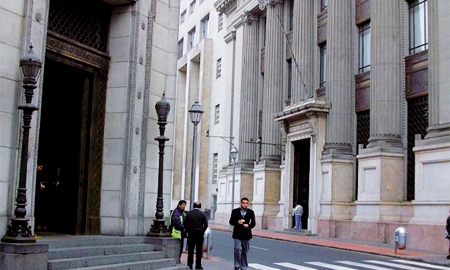Economic power and political stability: these are the two main characteristics that any foreign investor will find when going to do business in Peru, which has experienced a surprising period of growth and prosperity.
“The world needs to know that Peru today is radically different, in a positive sense, to how it was a couple of decades ago,” explains Roberto Hoyle, President of inPERU, one of the country’s most active promotion agencies. “Its sustained growth is based on solid foundations. The macroeconomic indicators are really positive, such as the gross domestic product (GDP), which in the last few years has been growing at a sustained average rate of at least 6%, as well as the region’s lowest inflation level.
“Overall, Peru has achieved very good results over the past few years in terms of growth, job creation, development, exports, and in promoting what we really are: one of the world’s most fascinating and culturally rich countries, which today is full of possibilities.”
Mr. Hoyle is also President of the Lima Stock Exchange, which has formed an alliance with the stock markets of Colombia and Chile to create one of Latin America’s most powerful financial markets with great future potential.
Following poor GDP growth of just 0.8% in 2009, the economy’s expansion rebounded to 8.8% in 2010 and 7% in 2011, coinciding with a drop in unemployment from 8.4% in 2009 to 7.5% in 2011, with the resulting increase in disposable income.
Over the past few years, both imports and exports have soared. Peru’s imports reached $36.97 billion in 2011, compared to $28.82 billion in 2010, and exports rose to $46.27 billion in 2011, up from $35.56 billion in 2010. This has no doubt helped the expansion and better functioning of basic national sectors, such as telecommunications, public services and established financing bodies, which contribute to robust, long-term economic development in general. Also in 2011, Peru’s growth in industrial production remained solid at 5%.
Peru has proven gas reserves estimated at 345.5 billion cubic meters (bcm), and exports approximately 3.6 bcm a year. In 2010, it became a net exporter of liquefied natural gas (LNG). The recent news that Mexico has signed an agreement to buy 360 million cubic feet per day of Peruvian natural gas in 2013, followed by 400 million in 2014 and 500 million in 2015, comes as no surprise. On the contrary, it reflects the current economic excellence of the Andean country.
Another sector that has grown exponentially is tourism. This fact, plus the general modernization of the Peruvian economy, has led to the opening of numerous businesses, such as bars, discos and nightclubs, in major cities such as Lima and Cuzco. Business tourism and gastronomy are the two main areas in which Peru wants to strengthen and modernize its offer.
The rapid growth experienced by the tourism sector has led the government to impose restrictions on the number of tourists that visit the world-famous Andean site Machu Picchu, an Inca city that attracts the largest number of visitors to the country. The only aim of the restrictions, say government sources, is to protect the site, which is highly sensitive to negative environmental results, such as soil erosion, and the general impact caused to the environment by the large concentration of tourists.
| Since 2006, Peru has signed trade deals with the U.S., Canada, Singapore, China, South Korea, Mexico and Japan; concluded negotiations with the European Free Trade Association and Chile; and begun trade talks with Central American countries |
The country’s abundant natural resources, such as copper, silver, gold, petroleum, timber, fish, iron ore, coal, phosphate and natural gas, were chiefly responsible for the rise in exports, as well as other emerging products, including chemical products, coffee, asparagus, and the quinoa plant – a raw material of which Peru is the world’s second biggest producer after Bolivia.
Peru’s economy reflects its varied geography, with an arid western coastal plain that faces the Pacific, the rugged Andean mountain region in the center with the highest point at 22,200 feet, and the eastern lowland jungle of the Amazon basin bordering Colombia and Brazil. The mountainous and coastal regions have important mineral resources, and the coastal areas include abundant fishing grounds. However, Peru’s dependence on mineral and metals exports, as well as imported foodstuffs, means that the economy is subject to world market price fluctuations. In addition, the growth in non-coastal areas is hindered by poor infrastructure.
One product the country produces is cocaine. Until 1996, Peru was the world’s biggest producer of the coca leaf. It now occupies the second spot, with an estimated 40,000 hectares in 2009, still well behind Colombia. Although the coca leaf is harmless and has been chewed by the indigenous population for centuries, it is used to make cocaine by mixing its main active ingredients with various chemicals.
“Peru enjoys legal, economic and political stability,” stresses Mr. Hoyle. “Peru has had sustained annual growth over the past decade. Its biodiversity and natural energy and mineral resources make it an attractive place to develop very big projects. In addition, it has a modern and stable legal framework, a democratic political context, and a solid macro-economic situation. In Latin America, Peru is the main producer of gold, zinc and other minerals. We are the main producer of silver worldwide. The internal market is also growing constantly and now trades, thanks to many treaties, with other markets in South America, the U.S., Asia and Europe. Being such a diverse country, Peru offers investment opportunities in many sectors, with equal conditions for all investors.”

0 COMMENTS